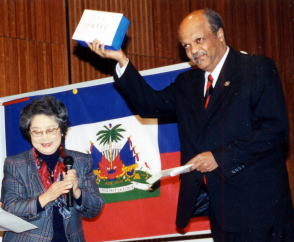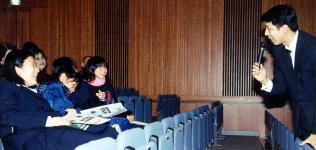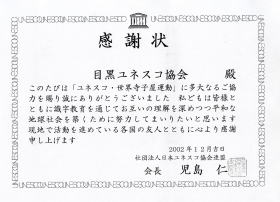No.194-2.3
|
|
Haiti, Coeur Battantü|Caribbean Heartbeatü@ ü@ü@ü@ü@ü@Report of Film Show
ü@ |
|
Date: Dec.14.2002ü@ü@ü@ü@ü@Place: Meguro Persimmon Hall (Small Hall)
ü@ü@Organizers: Haiti Embassy, Meguro UNESCO Associationü@Co-organizer: Meguro Board of Education
ü@ü@Supporter: Meguro International Friendship Association
ü@
ü@We would sincerely like to express our utmost appreciation again towards the producer of this film, His Excellency Mr. Marcel Duret, the ambassador of the Republic of Haiti in Japan. One hundred and ninety-eight years have passed since the Republic of Haiti achieved its national foundation. The descendants of brown-colored African slave immigrants, won their independence through beating Napoleonüfs Army. Mr. Marcel Duret made this film for the disadvantaged children who cannot receive education, on the occasion of National Foundation Two-Century Festival. He even appeared himself in some scenes of the film.
ü@The film opened with a steady stream of drawings reflecting the strong characteristics of Haiti. Next, it showed two pictures alternately; a picture of the Japanese traditional martial art, ügYabusameüh, and a picture of brown-colored old man in Haiti making drum from a piece of leather. A drum beat slowly as the picture alternated between scenes of Japan and scenes of Haiti. The pictures reflecting Japan showed the Shinkansen, automobiles moving smoothly on the beautiful road by the moat of the Imperial Place, and the Great Buddha at Kamakura. This contrasted sharply with the pictures reflecting Haiti; waves quietly breaking upon the white sandy beach, a coconut dropping to the ground with a thud, the bustling markets selling many kinds of fruit, and simple religious ceremonies based on animism. The drumbeat changed, sometimes becoming quite an enthusiastic tempo.
ü@The camera zoomed in to a Japanese woman and then moved to a female pianist,
whose piano music blended with the strong rhythm of the traditional Haitian
sounds. The film gradually revealed its theme: the encountering of  different values. The film narrated the history of how many people from different language backgrounds, fought together to win independence.
different values. The film narrated the history of how many people from different language backgrounds, fought together to win independence.
ü@As the end of the 64-minute film approached, clear opinions were conveyed.ü@ügThose
who do not know anotherüfs culture, cannot establish their own identitiesüh,
ügThose who stick to a certain place, Kamakura, Tokyo, Osaka, wherever,
and do not try to move beyond their boundaries, cannot understand their
own personalities.üh ügCulture, is something like thatüh. Haiti and Japan
have a vast geographical distance between them. For instance, when Japanese people see the sun rise, Haitian people see the sun set, and vice versa. These statements were very persuasive for the audience who, after seeing the film, now understand what is common and what is different between Japanese and Haitian people.
After the film show, Mrs. Kato, President of Meguro UNESCO Association, presented His Excellency Mr. Marcel Duret with a contribution. The money was from an education support grant from the Meguro UNESCO Association for children in Haiti, and also from fund-raising at he hall on the day.
| UNESCO Lecture ügAfghanistan Todayüh- The Present Situation of Educational
Support -ü@ |
|
ü@ü@ü@ü@Date: Dec. 12. 2002 (Mon.) 18:30-20:00ü@ Place: Meguro Persimmon Hall (Small Hall)
ü@ü@ü@ü@Speaker: Masanori Nagaoka from National Federation of UNESCO Associations in Japan
ü@
Mr. Masanori Nagaoka had just returned to Japan after his on-the-spot observation of the situation in Afghanistan and Pakistan. His report, with effective photos and videos, was very powerful and captivated the audience.
His speech started with the issue of the literacy rate in the world. He explained that eight hundred and eighty million (880,000,000) people suffer from their illiteracy and that six hundred million, approximately seventy-three percent of the total, live in Asian countries.
ü@To improve this situation, the National Federation of UNESCO Associations in Japan decided to conduct educational support activities chiefly in Asia. He then moved on to the current situation observed in Afghanistan. Supported with photographic evidence, the main points of his report regarding Afghanistan were as follows:
ü@ü@
ü@The refugees who moved from Afghanistan to Pakistan tried to return to Afghanistan at the end of the war. But many refugees fled back to Pakistan after being unable to find shelter to protect themselves from the severe
winter weather. Chiefly because of the war disturbances continuing since 1978, ninety-eight percent of Afghans are illiterate. They lack school buildings, teaching materials and all the things needed for conducting educational  activities. Both the number of teachers and the quality of teaching skills
are lacking. Education for girls was prohibited during the war years, while
boys were educated mainly through memorizing passages of the Koran. They
also have many other problems, besides the poor education. A big difference
exists in the amount of aid people can benefit from, depending on where
they live. Support from international organizations is concentrated in
cities. Improvement of the infrastructure is being delayed. Racial conflicts
continue. Emotional conflicts also exist between people who have escaped
to other countries and those who have remained within the homeland. Handing
over control and authority to public offices has been delayed because of
both authority and spheres of responsibilities of each department are unclear.
Many landmines still remain. People cannot leave their homes after sunset,
due to the general feeling of insecurity and fear of burglary. In spite
of this situation, the National Federation of UNESCO Associations in Japan
has recently opened its office in Kabul, the capital of Afghanistan, and
settled down to work there. The office is located in a safe area in the
center of Kabul. The office has various activities planned, such as ć@Building
schools, ćALiteracy education (both to children and adults), ćBTeacher
training, ćCVocational on-the-spot training, ćDImprovement of life (health
promotion; HIV treatment; family planning education; and skill support
on medical herb cultivation). The projects are located at ć@Istalif (approximately
60 kilometers from Kabul; being famous for traditional ceramics called
Istalif, and a major city of the area with a bazaar in the past), ćABamiyan
(where UNICEF opens a tent school), and 3. Mazar Dara village.
activities. Both the number of teachers and the quality of teaching skills
are lacking. Education for girls was prohibited during the war years, while
boys were educated mainly through memorizing passages of the Koran. They
also have many other problems, besides the poor education. A big difference
exists in the amount of aid people can benefit from, depending on where
they live. Support from international organizations is concentrated in
cities. Improvement of the infrastructure is being delayed. Racial conflicts
continue. Emotional conflicts also exist between people who have escaped
to other countries and those who have remained within the homeland. Handing
over control and authority to public offices has been delayed because of
both authority and spheres of responsibilities of each department are unclear.
Many landmines still remain. People cannot leave their homes after sunset,
due to the general feeling of insecurity and fear of burglary. In spite
of this situation, the National Federation of UNESCO Associations in Japan
has recently opened its office in Kabul, the capital of Afghanistan, and
settled down to work there. The office is located in a safe area in the
center of Kabul. The office has various activities planned, such as ć@Building
schools, ćALiteracy education (both to children and adults), ćBTeacher
training, ćCVocational on-the-spot training, ćDImprovement of life (health
promotion; HIV treatment; family planning education; and skill support
on medical herb cultivation). The projects are located at ć@Istalif (approximately
60 kilometers from Kabul; being famous for traditional ceramics called
Istalif, and a major city of the area with a bazaar in the past), ćABamiyan
(where UNICEF opens a tent school), and 3. Mazar Dara village.

ü@After the speaker explained all this, supported with photos, he showed us a video. The video showed broken towns and houses, the ruins of the Giant Buddha Statue in Bamiyan, the Silk Road being traveled by the traditional shepherds and camel caravans, plus several trucks, rolled onto their sides due to overloading. The childrenüfs bright smiles amid such a chaotic environment gave us a hopeful mind. Some questions were raised after watching the video.
ü@
üØGifts of Support Funding
Meguro UNESCO Association decided to grant one million yen of the profits from the UNESCO Peace Concert 2002 held on October 10th, to the National Federation of UNESCO Associations in Japan for educational support in Afghanistan. Mrs. Kato, the president of Meguro UNESCO Association, passed a certificate to Mr. Nagaoka.
Testimonial
To Meguro UNESCO Association
We would like to express our utmost appreciation for your great support of the ügWorld Terakoya Movement of UNESCOüh. We share in your wish to keep working through literacy education, to deepen mutual understanding and build up a peaceful society around the globe. This appreciation is echoed by our comrades in various nations working in the field.
December, 2002 National Federation of UNESCO Associations in Japan President
Hitoshi Kojima ü@ |
ü@ü@ü@ü@ü@ü@ü@ü@ü@ü@ü@ü@ü@ü@ü@ü@ü@ü@ü@ü@ü@ü@ü@ü@ü@ü@ü@ü@Reports by Mr.
Yoshio Shimizu
ü@
ü@
ü@ü@ü@ü@ü@ü@ü@ü@ü@ü@ü@ü@ü@ü@ü@ü@ü@ü@ü@ü@ü@ü@ü@ü@ü@ü@ü@ü@
 different values. The film narrated the history of how many people from different language backgrounds, fought together to win independence.
different values. The film narrated the history of how many people from different language backgrounds, fought together to win independence. different values. The film narrated the history of how many people from different language backgrounds, fought together to win independence.
different values. The film narrated the history of how many people from different language backgrounds, fought together to win independence. activities. Both the number of teachers and the quality of teaching skills
are lacking. Education for girls was prohibited during the war years, while
boys were educated mainly through memorizing passages of the Koran. They
also have many other problems, besides the poor education. A big difference
exists in the amount of aid people can benefit from, depending on where
they live. Support from international organizations is concentrated in
cities. Improvement of the infrastructure is being delayed. Racial conflicts
continue. Emotional conflicts also exist between people who have escaped
to other countries and those who have remained within the homeland. Handing
over control and authority to public offices has been delayed because of
both authority and spheres of responsibilities of each department are unclear.
Many landmines still remain. People cannot leave their homes after sunset,
due to the general feeling of insecurity and fear of burglary. In spite
of this situation, the National Federation of UNESCO Associations in Japan
has recently opened its office in Kabul, the capital of Afghanistan, and
settled down to work there. The office is located in a safe area in the
center of Kabul. The office has various activities planned, such as ć@Building
schools, ćALiteracy education (both to children and adults), ćBTeacher
training, ćCVocational on-the-spot training, ćDImprovement of life (health
promotion; HIV treatment; family planning education; and skill support
on medical herb cultivation). The projects are located at ć@Istalif (approximately
60 kilometers from Kabul; being famous for traditional ceramics called
Istalif, and a major city of the area with a bazaar in the past), ćABamiyan
(where UNICEF opens a tent school), and 3. Mazar Dara village.
activities. Both the number of teachers and the quality of teaching skills
are lacking. Education for girls was prohibited during the war years, while
boys were educated mainly through memorizing passages of the Koran. They
also have many other problems, besides the poor education. A big difference
exists in the amount of aid people can benefit from, depending on where
they live. Support from international organizations is concentrated in
cities. Improvement of the infrastructure is being delayed. Racial conflicts
continue. Emotional conflicts also exist between people who have escaped
to other countries and those who have remained within the homeland. Handing
over control and authority to public offices has been delayed because of
both authority and spheres of responsibilities of each department are unclear.
Many landmines still remain. People cannot leave their homes after sunset,
due to the general feeling of insecurity and fear of burglary. In spite
of this situation, the National Federation of UNESCO Associations in Japan
has recently opened its office in Kabul, the capital of Afghanistan, and
settled down to work there. The office is located in a safe area in the
center of Kabul. The office has various activities planned, such as ć@Building
schools, ćALiteracy education (both to children and adults), ćBTeacher
training, ćCVocational on-the-spot training, ćDImprovement of life (health
promotion; HIV treatment; family planning education; and skill support
on medical herb cultivation). The projects are located at ć@Istalif (approximately
60 kilometers from Kabul; being famous for traditional ceramics called
Istalif, and a major city of the area with a bazaar in the past), ćABamiyan
(where UNICEF opens a tent school), and 3. Mazar Dara village.